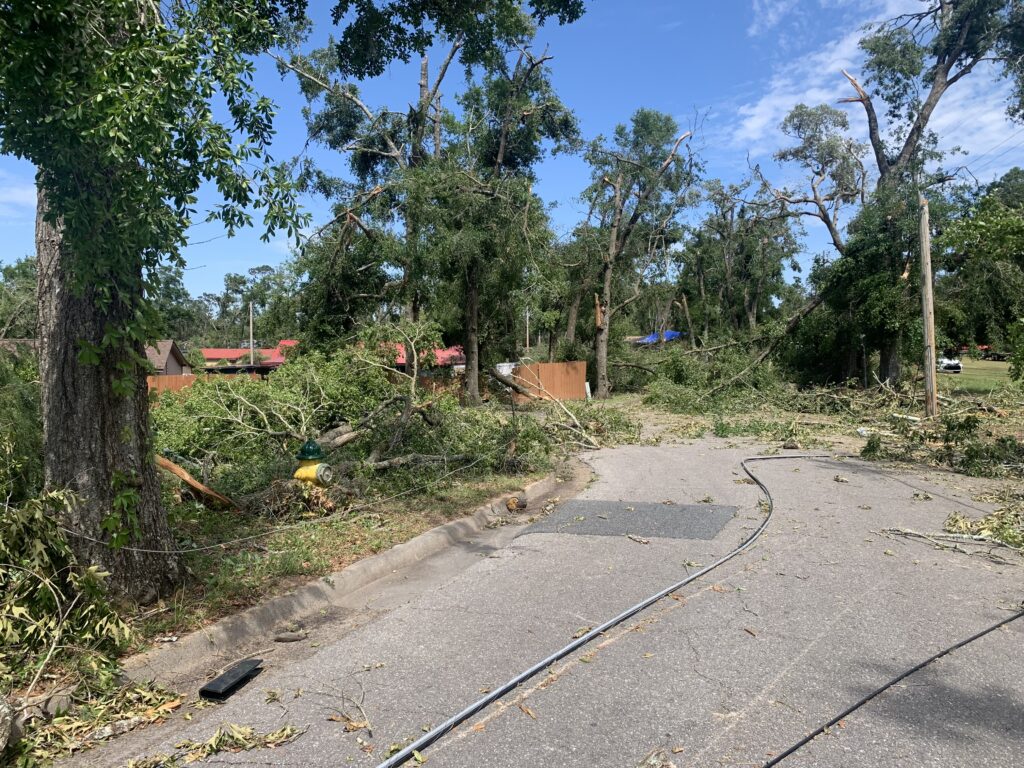
On Friday, May 10, Tallahassee was struck by catastrophic tornadoes that left a trail of devastation and tragedy in its wake. The storm, which hit with little warning, caused extensive damage across Leon and Gadsden counties, leaving residents reeling and authorities scrambling to respond.
The scale of the disaster is reminiscent of hurricanes, with Leon County officials estimating that it will take “some time” to reconnect an estimated 70,000 people to the power grid. Myers Park and Indianhead Acres, two of Tallahassee’s most heavily forested neighborhoods, bore the brunt of the storm’s wrath, with residents finding themselves virtually buried in fallen timber.
Amidst the chaos and destruction wrought by the recent tornado, one local family’s harrowing experience serves as a poignant reminder of the human toll of natural disasters. Amanda Love, a mother and Tallahassee resident, was at work when she received a horrifying call from her husband, who was at home with their 23-year-old daughter and her baby son when the tornado struck.
“I was devastated because I couldn’t get away. As soon as I got into the building of my job, the storms just kind of came out of nowhere,” Love said.
“Once he [my husband] explained to me at that moment that the storm was hitting, I could hear something loud through the phone as well as his voice. Something was going on.”
Love’s daughter, 23-year-old Denia Love, said she woke up to loud sounds from outside and immediately took her child to a safe place in the house.
“I got up and I looked outside, and I saw the tornado. So, I got my baby out of the bed and we ran into the hallway, and I heard all the trees falling,” Denia said.
“I was so paranoid and scared. I thought the trees were going to cave the roof in so I just kept running back and forth, up and down the hallway because I thought maybe it [the tree] would’ve fallen and the roof would’ve come with it. We were in the hallway for a good ten minutes.”
The Love family’s home was not spared from the tornado’s wrath. Trees crashed down onto their house, demolishing the master bedroom and destroying all their vehicles, trapping them inside. As Amanda Love’s mother-in-law, Sandra Love, recounted, their own home also suffered severe damages in the storm’s wake. She also described how frightening it was for parents who dropped their kids off for school when the storm hit.
“We got no warning as far as them going to school, none at all. I don’t know if they knew how severe it was going to be but, the kids were still allowed to go to school, and that really did something to me because those are kids,” Sandra said.

“To know that some kids were standing on the corner of my street and they were still out there, waiting for the bus. My neighbor said as soon as her son and the other kids got on the bus, they had to pull off to the side of the road because the storm came out of nowhere. And the way it hit over here, I’m surprised our houses are still standing.”
Reflecting on their experience, the Love family is advocating for greater measures to prevent similar tragedies in the future. They believe that the city should consider removing more trees from forestry neighborhoods and communities, as the majority of the damage they endured was caused by massive tree falls. According to the Loves, much of the devastation to their home could have been avoided if they had been able to remove the trees surrounding their property.
Their plea for action resonates with many in Tallahassee, where the aftermath of the tornado has prompted discussions about improving disaster preparedness and mitigation efforts.
The impact on education was profound, with schools across the city forced to close as a result of the destruction. Florida A&M University (FAMU), in particular, faced significant damage, prompting President Larry Robinson to declare a state of emergency. At least 15 buildings on the FAMU campus, including the Grand Ballroom and the Banneker Buildings, suffered roof and water damage, disrupting normal operations.